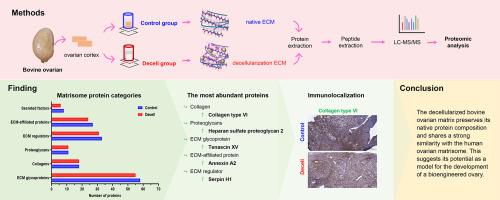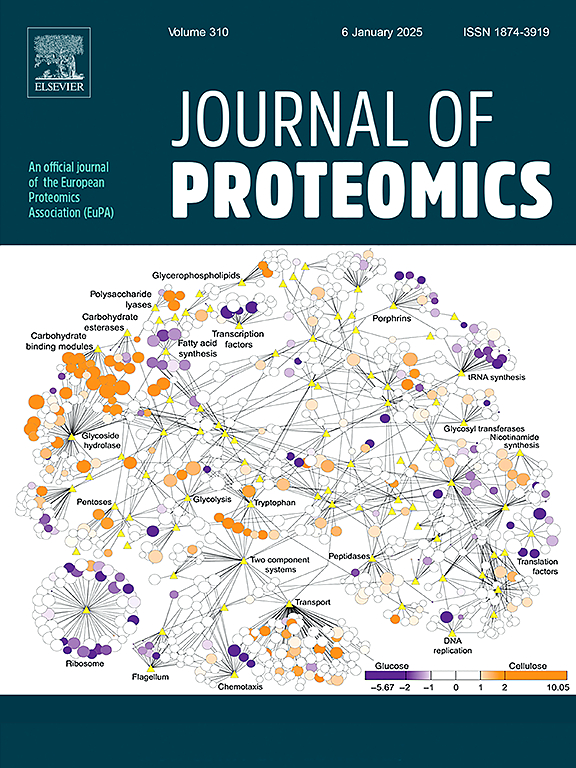Decellularized extracellular matrix from bovine ovarian tissue maintains the protein composition of the native matrisome
IF 2.8
2区 生物学
Q2 BIOCHEMICAL RESEARCH METHODS
引用次数: 0
Abstract
Recent approaches of regenerative reproductive medicine investigate the decellularized extracellular matrix to develop a transplantable engineered ovary (TEO). However, a full proteomic analysis is not usually performed after the decellularization process to evaluate the preservation of the extracellular matrix (ECM). In this study, the ECM of the bovine ovarian cortex was analyzed before and after decellularization using mass spectrometry and bioinformatics. A total of 155 matrisome proteins were identified in the native ECM of the bovine ovarian cortex, with 145 matrisome proteins detected in the decellularized ECM. After decellularization, only 10 matrisome proteins were lost, and notably, none belonged to the category of reproductive biological processes. Histology and histochemistry analyses were employed to assess the general morphology of both native and decellularized ECM, allowing for the identification of the most abundant ECM proteins. Moreover, our study highlighted collagen type VI alpha 3 and heparan sulfate proteoglycan 2 as the most abundant components in the bovine ovarian ECM, mirroring the composition observed in the human ovary. These findings enhance our understanding of the composition of both native and decellularized ECM, with the potential implications for the development of a TEO.
Significance
The significance of the present study lies on the possibility of advancing towards developing a bioengineered ovary, which is the ultimate strategy to regain fertility in women. The results demonstrate that the decellularized extracellular matrix of the bovine ovary maintains the protein composition of the native matrisome, using a recently described decellularization protocol. The decellularized matrix may serve as scaffolding for seeding ovarian stromal cells and follicles to create a bioengineered ovary, and as closer its composition is to the native matrix the better. Also, comparing the bovine ovarian matrisome, which was described for the first time here, with the human ovarian matrisome, we could see a great similarity, suggesting that the bovine ovary decellularized matrix may serve as a model for developing a human bioengineered ovary.

牛卵巢组织脱细胞细胞外基质保持了原生基质的蛋白质组成。
最近的再生生殖医学方法研究了脱细胞细胞外基质,以开发可移植工程卵巢(TEO)。然而,通常不会在脱细胞过程后进行全面的蛋白质组分析,以评估细胞外基质(ECM)的保存情况。本研究利用质谱法和生物信息学分析了脱细胞前后牛卵巢皮质的 ECM。在牛卵巢皮质的原生 ECM 中共鉴定出 155 个 matrisome 蛋白,在脱细胞 ECM 中检测到 145 个 matrisome 蛋白。脱细胞后,只有 10 个 matrisome 蛋白丢失,值得注意的是,没有一个属于生殖生物过程类别。通过组织学和组织化学分析评估了原生和脱细胞 ECM 的总体形态,从而确定了最丰富的 ECM 蛋白。此外,我们的研究突出表明,VI 型胶原蛋白α 3 和硫酸肝素蛋白多糖 2 是牛卵巢 ECM 中含量最高的成分,这与在人类卵巢中观察到的成分一致。这些发现加深了我们对原生和脱细胞 ECM 组成的了解,对 TEO 的开发具有潜在影响。意义:本研究的意义在于有可能推进生物工程卵巢的开发,这是恢复女性生育能力的最终策略。研究结果表明,采用最近描述的脱细胞方案,脱细胞的牛卵巢细胞外基质保持了原生基质的蛋白质组成。脱细胞基质可作为播种卵巢基质细胞和卵泡的支架,以创建生物工程卵巢,其成分越接近原生基质越好。此外,我们还将这里首次描述的牛卵巢基质组与人类卵巢基质组进行了比较,发现两者非常相似,这表明牛卵巢脱细胞基质可作为开发人类生物工程卵巢的模型。
本文章由计算机程序翻译,如有差异,请以英文原文为准。
求助全文
约1分钟内获得全文
求助全文
来源期刊

Journal of proteomics
生物-生化研究方法
CiteScore
7.10
自引率
3.00%
发文量
227
审稿时长
73 days
期刊介绍:
Journal of Proteomics is aimed at protein scientists and analytical chemists in the field of proteomics, biomarker discovery, protein analytics, plant proteomics, microbial and animal proteomics, human studies, tissue imaging by mass spectrometry, non-conventional and non-model organism proteomics, and protein bioinformatics. The journal welcomes papers in new and upcoming areas such as metabolomics, genomics, systems biology, toxicogenomics, pharmacoproteomics.
Journal of Proteomics unifies both fundamental scientists and clinicians, and includes translational research. Suggestions for reviews, webinars and thematic issues are welcome.
 求助内容:
求助内容: 应助结果提醒方式:
应助结果提醒方式:


